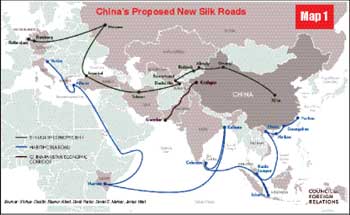Wednesday Dec 31, 2025
Wednesday Dec 31, 2025
Thursday, 28 September 2017 00:02 - - {{hitsCtrl.values.hits}}
When the new Government came to office in January 2015, followed by August elections, it had misgivings about the previous regime having dubious connections with some Chinese companies. On that premise, all Chinese projects, investments and loans were suspected.
During the heated election campaign, there were promises given to review, halt or overturn some of the major projects; Colombo Port City and Hambantota Port being the main ones. It is also true that some sections of the new government was utilising the opportunity to change the foreign policy more towards the West.
One valid reason for this orientation was the concern about democracy, reconciliation and human rights. However, that cannot be the whole concern in a developing country like Sri Lanka. Economic development itself should be a major priority. Unless the economy and living standards develop; democracy, reconciliation or human rights cannot be achieved or sustained.
A lacunae
One main defect in Sri Lanka’s economic strategy or external relations is the lack of broad national policies on key issues. It is true that in a democratic party system, one cannot expect all or even the main parties to follow the same policy. That is not necessary and in fact unhealthy. However, there should be broad ‘national policies’ particularly in respect of external relations, both in politics and economics.
Sri Lanka today ostensibly is in a better position to achieve that given the UNP and the official SLFP are in the same government. Yet, do we have such a framework? Or do we have other external constraints to achieve such?
 Sri Lanka of course should not emulate China in politics, although China is changing. Sri Lanka has inherited and followed the ‘Western’ democratic institutions and those should be considered ‘universal,’ as products of human civilisation. However, not following China in politics should not be a constraint to follow or benefit out of China’s economic progress. This should not be an opportunistic venture, but a genuine effort to economically cooperate. This is also not a restriction to cooperate with other countries particularly with India. A Chindia (China-India) policy might be the best.
Sri Lanka of course should not emulate China in politics, although China is changing. Sri Lanka has inherited and followed the ‘Western’ democratic institutions and those should be considered ‘universal,’ as products of human civilisation. However, not following China in politics should not be a constraint to follow or benefit out of China’s economic progress. This should not be an opportunistic venture, but a genuine effort to economically cooperate. This is also not a restriction to cooperate with other countries particularly with India. A Chindia (China-India) policy might be the best.
China does not demand or has not demanded, any country to cooperate economically only with her. Their offers are open ended, while it is understandable that they would try naturally to safeguard their interests. It is up to the cooperating countries, and Sri Lanka in this case, to bargain for our own interests. However, given their enormous external resources, they could be magnanimous, particularly to developing and small countries.
China is increasingly using common international vocabulary in their statements such as ‘win-win solutions,’ ‘democracy,’ ‘rule of law’ and ‘reconciliation.’ They often refer to the ‘international community.’ NGOs are a newest addition. They may have their own interpretations on some of them, but emphasis on ‘harmony,’ instead of ‘confrontation,’ is one of their traditional civilisational goals.
Belt and Road
Belt and Road Initiative (BRI) is one of their newest development strategies launched in 2013, although economic cooperation goes back to several years or decades. China has become the world champion of economic globalisation today while many of the Western countries are now retreating from their own initiatives. This is one reason why a country like Sri Lanka cannot rely too much on FDI (Foreign Direct Investments) from the West any longer. Of course the possibilities are there from India, however BRI is completely a different initiative, strategically important to Sri Lanka.
The following is what a former Ambassador to China, Nihal Rodrigo, said well before the BRI, in 2009 at a conference: “Sri Lanka has, for centuries, been a major mid-point in the Silk Route of the Sea which linked it with the East and the West – links which continues to develop.”
Therefore, for our own benefit, BRI is strategically important. Obviously, it is not so much of the Belt that is important to Sri Lanka but the Road. While the Belt is a land route with several corridors, the Road is several maritime trade routes, the main one being via or near Sri Lanka. Map 1 gives a rough idea about the BRI.
China is well known in the world history for its Great Wall. I think I came to know about it in grade three. That was built several centuries ago to prevent invasions from cavalry nomads from central Asia. Later on, China invented the Silk Route to promote trade, instead of war, even with those nomadic communities.
It was the same idea that was extended as the maritime Silk Road connecting China, through Southeast and South Asia to the Gulf. On our part, it was also called the Spice Road, towards the West. Tamil Nadu also played a major role in this route. However, this was abandoned due to both internal and external reasons, but the route existed benefitting (or harming) Sri Lanka. Many counties in this route, on the Eastern side, were of rice eating people like us.
Those days, the main trading product of China was silk. While men tilled the land, women raised mulberry trees and extracted silk fibre from the mulberry worm in the cocoon. Silk textile was a major product. Today, China is into many other merchandises (not always so perfect) and it is a large market for other countries, although Sri Lanka has not yet utilised the potential.
It is in 1952, 65 years ago, that Sri Lanka entered into the famous Rubber-Rice Pact, favourable to our country, although trade did not expand satisfactorily thereafter. Trading and commercial skills are something Sri Lankans are terribly lacking, much to be learn from the Chinese. Despite John Kotelawala’s snub against Zhou Enlai during the Bandung conference (1955), China has maintained a favourable disposition towards Sri Lanka continuously. Sri Lanka was one of the first countries to recognise China after the revolution, along with India. It was Jawaharlal Nehru who was on Zhou Enlai’s side when that uncivilised snub happened.
A few years back, I met a Chinese academic at the University of Sydney, who said she was a small girl to give a bouquet to Sirimavo Bandaranaike at an official reception when the latter visited China in 1972. She was fascinated about Sirimavo’s saree!
BRI deliverables
Colombo Port City or Hambantota is not all about the Belt and Road initiative. The vision and the strategy are much more profound. Some critics have argued that it is too ambitious; but that is pure speculation and should not be our present concern.
It was unfortunate that after the government change in 2015, many Chinese projects became temporarily halted, even affecting the growth rate adversely. This was due to the absence of common national policies, and/or agreed standards in undertaking such projects. In a bizarre turn, when the new Government wanted to proceed with them,  the supporters of the last Government violently protested.
the supporters of the last Government violently protested.
There can’t be much doubt that some people in the last Government profited out of these projects, allegedly taking commissions from Chinese companies. The China connection also was utilised for political purposes. This can happen under any government. What is necessary is to have strict standards on our part, making known them to the Chinese partners. A distinction also should be made between Chinese companies and the Chinese Government.
My main point is about the Belt and Road Forum (BRF) held in Beijing on 14-15 May this year, and whether we have utilised the opportunity for the maximum benefit. At the Forum, China has pledged $ 40 billion for both Belt and Road; $25 billion being for the Road. I am quoting from the Council on Foreign Relations. China has also identified 270 deliverables, under five key areas, and 68 countries and international organisations have signed different agreements under them.
It was unfortunate that India could not or did not participate at the Forum because of the controversial China-Pakistan Corridor which supposed to run through the disputed Kashmir. This might be sorted out amicably in the future, and that should not be a reason for Sri Lanka to become hesitant on the BRI. Sri Lanka even could play a role in sorting it out like what Mrs Bandaranaike attempted in 1962.
The five key areas of the BRI at present are as follows: (1) Connectivity of Development Policies and Strategies. (2) Project Cooperation for Infrastructure Connectivity. (3) Industrial Investment and Trade Connectivity. (4) Financial Cooperation and Financial Connectivity. (5) People’s Livelihood and People-to-People Exchange.
There are countries who have signed agreements in all these areas, and some more than one in a single area. It is not only Asian governments who have signed agreements. The prominent others include many of the Eastern European countries, Russia, EU and countries like Greece, Netherlands and Switzerland. Of course signing agreements is not the most important, unless those are with deliverable capacity. For example, during President CBK’s visit in September 2005 to Beijing, there was an agreement to set up Confucius Institute/s, however the first one was inaugurated only in 2007 (University of Kelaniya) and the second last year at the University of Colombo. Those days the emphasis was more on cultural cooperation.
Are we lagging behind?
XinhuaNet (15 May) has listed all 270 agreements as deliverables with monies earmarked in some cases, in general terms. Some however should be understood as credit and loans. Sri Lanka has signed 5 of them: one under Project Cooperation for Infrastructure Connectivity; three under Industrial Investment and Trade Connectivity; and one under Financial Cooperation and Financial Connectivity. These are undoubtedly important, but most of them appear formalisation of what have already agreed upon i.e. Hambantota. Sri Lanka has also signed an additional Concessionary Agreement in July to develop Hambantota.
What might be significantly absent is a MOU on BRI itself, under the first category. The government to government MOUs in this category are with Mongolia, Pakistan, Nepal, Croatia, Montenegro, Hungary, Cambodia, Lao PDR, Bosnia and Herzegovina, Albania, Timor-Leste, Singapore, Myanmar and Malaysia. Sri Lanka is missing here. The Chinese government also has signed cooperate documents under this category with most of the multilateral organisations such as UNDP, WHO, WIPO, UNPF etc.
Two agreements that Sri Lanka has signed with the Chinese government on (1) Economic and Trade Cooperation and (2) Promotion of Investment and Economic Cooperation, under category three, can be considered the most important, if they are followed up properly. Other three are ministry to ministry or institution to institution agreements.
Another area Sri Lanka has apparently missed out is on ‘People’s Livelihood and People to People Exchange.’ The declared objectives of ‘people’s livelihood’ are quite broad from emergency to poverty alleviation, and basic needs. The funds allocated are also not small, and not loans. Many of the offers in this area could have been utilised for rehabilitation and reconstruction in the North and the East.
China’s BRI does not limit to governments or investment projects. There has also been a non-governmental (NGO) area emphasised at the Forum. With 80 member organisations, China NGO Network for International Exchange has sought ‘people to people’ exchange and networking. China appears to emulate some Western countries in this respect, and it is a welcome move. Sri Lanka or its NGO sector also seems to have missed out in this initiative.